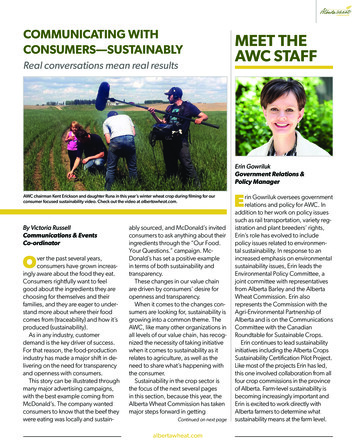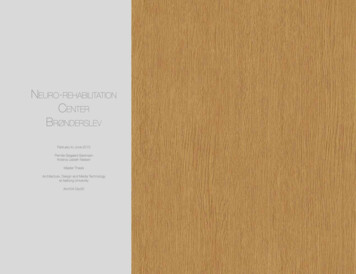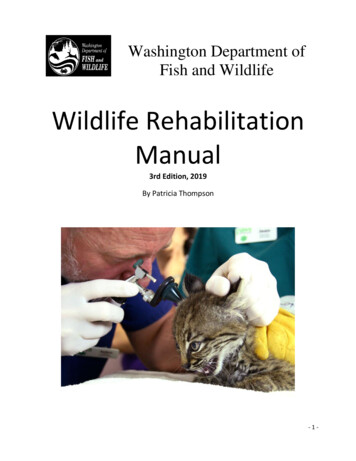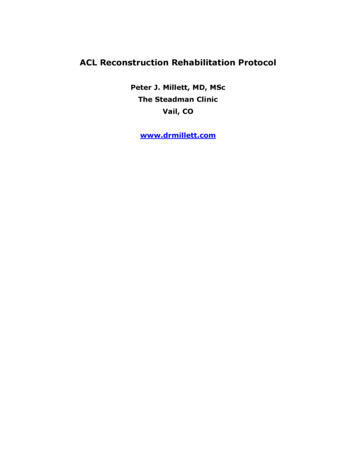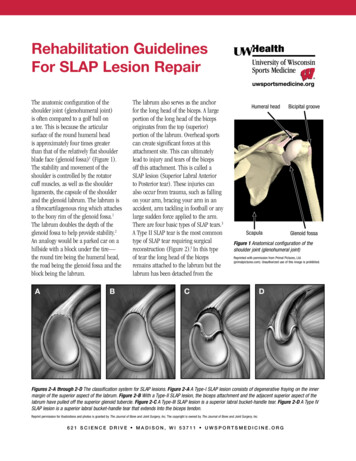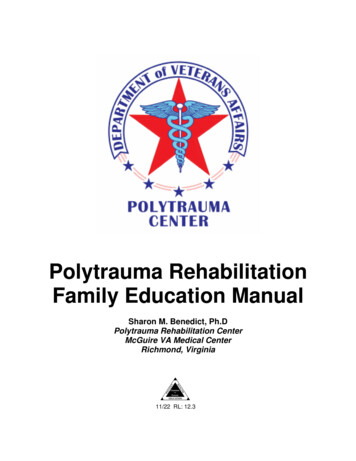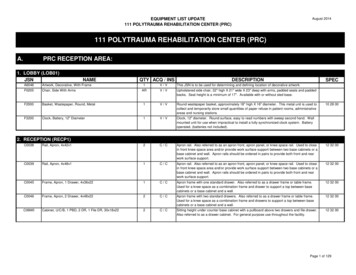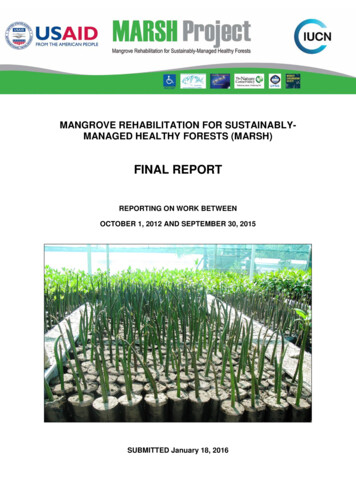
Transcription
MANGROVE REHABILITATION FOR SUSTAINABLYMANAGED HEALTHY FORESTS (MARSH)FINAL REPORTREPORTING ON WORK BETWEENOCTOBER 1, 2012 AND SEPTEMBER 30, 2015SUBMITTED January 18, 2016
Cover photo: A mangrove nursery in the Central Province established by theMARSH projectPhoto: MARSH PMUMangrove Rehabilitation for Sustainably-Managed Healthy ForestsFinal ReportPrepared for Cooperative Agreement to a Public International Organization No. AID492-A-12-00010, USAID, PhilippinesSubmitted to:Randy John Vinluan, Agreement Officer’s Representative, USAID/Pacific IslandsBy:IUCN Regional Office for Oceania, International Union for the Conservation ofNatureSubmitted on:January 18th, 2016Contacts:Mr. Taholo KamiDr. Milika SobeyIUCN Oceania Regional OfficeIUCN (International Union forConservation of Nature)IUCN Oceania Regional OfficeIUCN (International Union forConservation of Nature)Private Mail Bag 5 Ma’afu Street,Suva, Fiji IslandsPrivate Mail Bag 5 Ma’afu Street,Suva, Fiji Islandstel. 679 3319 084fax. 679 3100 128tel. 679 3100 392fax. 679 3100 128Email: taholo.kami@iucn.orgEmail: milika.sobey@iucn.org2
Table of ContentsAcronyms and Abbreviations. 4Executive Summary . 612Introduction . 81.1General Climate Change impacts in Melanesia and the broader Pacificregion . 81.2Pacific Mangroves and climate change impacts across MARSH geographies . 91.3Scope and objectives of the Project . 101.4Achieving MARSH objectives through Partnership . 121.5MARSH Sites and Priority Provinces . 13Description of Activities under the Cooperative Agreement . 162.1Capacity building . 162.2Awareness-raising. 223Methods of Assistance Used and their Pros and Cons . 244Life of Project Results . 284.156Overview of Progress on Standard Indicators for MARSH project targets . 31Problems and Lessons Learnt . 385.1Problems identified by the RIG audit and Response from IUCN . 385.2Lessons Learnt. 40Annexes . 426.1Overview map of PNG with MARSH sites highlighted. 426.2Detailed map of MARSH site Central Province . 436.3Detailed map of MARSH site Manus Province . 446.4Detailed map of MARSH site National Capital District . 456.5Detailed map of MARSH site New Ireland Province . 466.6Detailed map of MARSH site West New Britain Province . 473
Acronyms and NUPASOCCDOROPDFPMPPMUPNGPNG ADPPNG CLMAPNGFAPPPPWMRCFRIGSIAward Monitoring PlanAreas of InterestCommunity Based OrganizationCenter for Environmental Law and Community Rights IncCustom IndicatorCenter for Locally Managed AreasDepartment of Environment and ConservationDisability Provincial OfficerData Quality AssessmentEl Niño–Southern OscillationInternational Panel for Climate ChangeInternational Union for Conservation of NatureLowering Emissions in Asia's ForestsLocal Level GovernmentMangrove Rehabilitation for Sustainably-Managed Healthy ForestsManus Environmental Conservation Community NetworkMangrove Ecosystems for Climate Change Adaptation andLivelihoodsMotupore Island Research CentreNational Agricultural Research InstituteNew Britain Palm Oil LimitedNational Capital District (PNG)National Fisheries AuthorityNon-Government OrganizationNon-US Pre-Award SurveyOffice of Climate Change and DevelopmentOceania Regional OfficePacific Disability ForumPerformance Monitoring PlanProject Management UnitPapua New GuineaPapua New Guinea Assembly of Disabled PeoplePapua New Guinea Center for Locally Managed AreasPapua New Guinea Forestry AuthorityPrivate Public PartnershipPartners With MelanesiaResearch & Conservation FoundationRegional Inspector GeneralSolomon Islands4
SLRSPREPTNCUPNGUSAIDUSGWCSWNBWWFSea Level RiseSecretariat of the Pacific Region Environment ProgrammeThe Nature ConservancyUniversity of Papua New GuineaUnited States Agency for International DevelopmentUnited States GovernmentWildlife Conservation SocietyWest New Britain (Province PNG)World Wide Fund for Nature5
Executive SummaryThe project Mangrove Rehabilitation for Sustainably Managed Healthy Forests(MARSH) commenced on October 1st 2012 and ended on September 30th 2015. Theproject was initially supposed to be implemented over five years in Papua NewGuinea (PNG), Solomon Islands and Vanuatu. In the first quarter of Year 3 the donordecided to change the focus from community based to national interventions forgreater impact and to limit the rest of the activities of the third year to PNG alone.The project life span was thus shortened and there was nothing started in SolomonIslands and Vanuatu.The project was implemented at 23 sites in five provinces in Papua New Guinea:National Capital District, Central, Manus, West New Britain and New Ireland.The main goal of the project was to empower communities and increase capacitiesof national institutions in the rehabilitation and management of mangrove forests toincrease resilience to the impacts of climate change.To implement the project across the five provinces, IUCN partnered with a number ofnational and international NGOs. These were The Nature Conservancy (TNC);Wildlife Conservation Society (WCS); PNG Centre for Locally Managed MarineAreas (PNGCLMA); Partners with Melanesians (PWM), PNG Assembly of DisabledPersons (PNGADP); and University of PNG (UPNG).A mangrove use survey of 1268 households in 52 villages, 12 Local LevelGovernments (LLG) and three provinces revealed a very high dependence onmangrove ecosystems for food, firewood and construction materials. The surveyresults spurred communities to incorporate mangrove management in theircommunity resource plans. The results of the surveys also fed into policyformulation and management plans by LLGs in Manus and West New Britain. Theeconomic value of mangrove fishery products was estimated at PGK600, 000 perannum for Kimbe urban market alone further highlighting the economic and foodsecurity provided by mangroves. Mangrove health assessments were conducted insix villages in New Ireland that showed healthy mangrove forests overall.There were 13,186 mangrove seedlings planted in 40 villages in 11 LLGs in the fiveprovinces. Such was the strong community leadership and support for this activity.There were some 66 formal and informal training courses held and there wasreasonable gender balance with some 40% of the participants being women. Therewere two national events held in the final year that ended the project on a high note.There was the national mangrove carbon accounting training workshop and thesecond was the Mangoro Bung which brought all stakeholders working on mangroveconservation in PNG together, to strategize on the formulation of a national6
mangrove policy. There were key knowledge products produced which included aDisability Inclusion Training Manual produced by PNGADP, a first for the country.The implementation of activities only really started in year 2 of the project due tolengthy contractual deliberations with sub-awardees and in securing community buyin in year 1. The ambitious project targets, the remoteness of sites, high costs andlocal partners that were under-resourced were few of the challenges to timelyimplementation of project activities.Despite the challenges and setbacksexperienced in this project, there were many lessons learnt and the legacy of theMARSH project is a very strong network of agencies and communities committed tofurthering mangrove conservation in PNG. There was also a groundswell incommunity support for mangrove conservation in the five provinces that will hopefullyextend to the other maritime provinces that have mangroves.7
1 IntroductionMarine and coastal resources provide livelihoods for more than 100 million peopleliving in the coastal areas of the Coral Triangle and Melanesian countries–Malaysia,the Philippines, Indonesia, Papua New Guinea (PNG), Solomon Islands, TimorLeste, and Vanuatu. These countries are already experiencing the effects of climatechange, such as an increase in water temperature and acidity stressing the coralreefs and causing bleaching; sea-level rise eroding coastlines, especially of low-lyingislands, affecting critical nursery grounds for local fisheries; and increased frequencyand severity of tropical storms results in flooding of coastal villages and nearbyagricultural lands.Sensitive coastal ecosystems like mangroves, salt marshes, and coral reefs face aneven more rapid destruction worldwide than tropical forests. Climate change impactsare exacerbating the already urgent threats of unsustainable use and destructiveland-use and fishing practices in these regions. Furthermore, coastal and marineecosystems are of great relevance - though sometimes still underestimated - forcarbon storage and, if intact, may offer further protection against effects of climatechange. In order to counteract these negative impacts the countries of the CoralTriangle region have declared their commitment to the sustainable use andconservation of marine and coastal resources, and to address the impacts of climatechange at the highest level, through the recent Coral Triangle Initiative 1, CoralTriangle Ministerial Communiqué on Climate Change 2 and various national policiesand programs in each country reflected in the regional and national plans of action.1.1 General climate change impacts in Melanesia and the broaderPacific regionIslands and low-lying coastal areas are particularly vulnerable to climate change dueto their small size, isolation, and generally low income levels and relatively low levelphysical infrastructure. All Mangrove Rehabilitation for Sustainably-Managed HealthyForests (MARSH) target sites are bracing for the impacts of climate change, and insome cases, impacts are already occurring (coastal erosion and saltwater intrusionin Manus, Kavieng, New Britain). Many coastal areas of PNG have very highpopulation densities (thus large numbers of people potentially exposed tohazards/climate events).Globally, estimates for projections of sea surface warming by 2100 range from 26 C, more intense tropical storms are anticipated, and sea level is projected toincrease by 1-2m by 2100 (IPCC 2007). Regionally, modest declines in annual1The Coral Triangle is the global centre of coral biodiversity (Malaysia, Indonesia, the Philippines, Timor Leste, Solomon Islands & PNG) andthe CT Initiative was adopted by the Heads of Government for these countries in Manado, May 2009.2Adopted by Ministers of the six Coral Triangle countries in Gizo, Solomon Islands (November, 2009)8
precipitation in the Pacific are anticipated, along with heavier rainfall intensity.Regional sea level patterns in the Pacific over the past century suggest that sealevel is subject to large inter-annual variations driven by ENSO cycles. Overlayingthese short term changes is a long-term sea level rise of about 1.6mm per year,however considerable regional variation exists. Evidence suggests that sea-level rise(SLR) is accelerating throughout the tropical Pacific.In most islands and coastal areas of PNG, Solomon Islands and Vanuatu themajority of the population and infrastructure are located within a few hundred metersof the coast; therefore, they are highly vulnerable to the impacts of climate change,specifically sea-level rise. Flood risk is projected to be 200 times greater thanpresent for Pacific countries by 2080.1.2 Pacific mangroves and climate change impacts across MARSHgeographiesIn PNG and other island nations, mangroves are critical for coastal communities whodepend on them for income generation and basic needs such as fuel, fibers, food,and protection from storm surges. This project will support sustainable managementof these ecosystems to maintain the range of co-benefits they provide to thethousands of people who live in the communities and countries where we will workand who will be most impacted by their degradation.Mangrove forests are among the world's most economically valuable ecosystems interms of providing multiple ecosystem services, including climate regulation, but areamong the most threatened ecosystems due to pressures from increasingpopulations and their need for food, construction materials, medicines and othertraditional uses. Large tracts of mangroves are being converted for industrialdevelopment, tourism infrastructure, aquaculture and the subsequent market andregulatory failures have contributed to their decline.Coastal ecosystems such as mangroves cover only 1-2% of the total area occupiedby forest ecosystems, but may have an annual climate change mitigation potential of7-20% of the annual emissions from global deforestation and forest degradation. Thelatest estimates of mangrove forests areas in the three Melanesian countries are:Papua New Guinea 480,121 Ha, Solomon Islands 47,099.66 Ha, and Vanuatu1,378.17 Ha 3.Island nations, such as Papua New Guinea, Solomon Islands and Vanuatu, areamong the most vulnerable countries to climate change and contain extensivemangrove forests that may be very important for global climate change mitigation, aswell as, for providing other ecosystem services that are important for local3Bhattarai B. & C. Giri, 2011. Assessment of mangrove forests in the Pacific Region using Landsat imagery. Journal of applied RemoteSensing, (5): pp. 11.9
livelihoods, national economies and climate change adaptation. In these countries,mangroves provide timber, shoreline protection, and support food fisheries. Takentogether, holistic ecosystem service assessments and economic valuations caninform environment and development planning and policies that integrate costeffective approaches to climate change mitigation and climate change adaptation.Globally, the implied rates of loss for mangroves are faster than of tropicalrainforests or coral reefs, but generally receive far less attention. The rate ofmangrove deforestation was 1.7 percent a year from 1980 to 1990 and 1.0 percent ayear from 1990 to 2000 (FAO, 2003), slowing to 0.66 percent in the five years before2005. In Papua New Guinea and the other Melanesian countries the following directhuman impacts on mangroves lead to habitat degradation and deteriorating waterquality: conversion to aquacultureconversion to agricultureoverharvesting for timberunsustainable fishing and other extractive usesconversion to development, tourism and coastal infrastructurepollutionClimate change has begun to compound the effects of many of these threats.Degradation and loss of these coastal systems due to climate change and directhuman impacts negates the protection they provide during extreme events andreduces their adaptive capacity, with significant environmental, social and economicconsequences for coastal communities. It has been substantially demonstrated thatmangroves are affected by climate change (Nicholls et al., 2007). Temperatureincreases and the direct effects of CO2 increases are likely to be mostly beneficial,increasing mangrove productivity and biodiversity. Rainfall changes are of greatersignificance to mangroves, particularly reduced rainfall, which decreases productivityand biodiversity. However, the effects of relative sea level rise are the primary impactof concern, with a number of severely detrimental effects on mangroves 4 (Nicholls etal. 2007).1.3 Scope and objectives of the projectIn order to achieve the scope of the project described above, the MARSH projectfocused on the following objectives:4Nicholls, R.J., P.P. Wong, V.R. Burkett, J.O. Codignotto, J.E. Hay, R.F. McLean, S. Ragoonaden and C.D. Woodroffe, 2007: Coastal systemsand low-lying areas. Climate Change 2007: Impacts, Adaptation and Vulnerability. Contribution of Working Group II to the FourthAssessment Report of the Intergovernmental Panel on Climate Change, M.L. Parry, O.F. Canziani, J.P. Palutikof, P.J. van der Linden and C.E.Hanson, Eds., Cambridge University Press, Cambridge, UK, 315-356.10
1.1.1.1To build the capacity of PNG Universities, National and sub-nationalinstitutions, including mangrove carbon monitoring, reporting andverification1.1.1.2aTo strengthen the organisational capacities of civil society to supportsustainable development through community-based mangrove forestmanagement1.1.1.2bTo strengthen community capacity on sustainable mangrove forestmanagement1.1.1.4To strengthen the adaptive capacity of coastal communities throughcommunity-based mangrove forest management1.3.1.1To support community rehabilitation and sustainable management ofmangrove forests1.3.1.2To explore sustainable finance models and mechanisms that supportlong-term community-based mangrove forest management, including;o adaptation funding (Adaptation stream)o REDD / mangrove carbon finance (Sustainable Landscapesstream)The MARSH project contributed to two intermediate results under USAID’s PacificIslands Results Framework Development Objective “Negative Impacts of ClimateChange Addressed” (see Section VII, Annex VII for Results Framework) specificallysub-IR 1.3.1 “Forest Management Capacity Strengthened” under IR 1.3“Deforestation and Forest Degradation Reduced” and sub-IR 1.1.1 “Coastal ZoneManagement Improved” under Intermediate Result 1.1 “Resilience in CommunitiesStrengthened.”Intermediate Result 1.1Intermediate Result 1.3Resilience incommunitiesstrengthenedDeforestation and forestdegradation reducedsub IR 1.1.1sub IR 1.3.1Coastal zone management improvedForest management capacitystrengthened Scientific capacity building for PNG Universities,National and Sub-National Institutions, includingforest carbon monitoring, reporting, andverification. Capacity building for communities on climatechange adaptation and sustainable mangroveforest management.11 Increase community support and capacityto rehabilitate and sustainably managemangrove forests
The audit conducted by the Office of the Regional Inspector General (RIG) of theMARSH project in October/November 2014 found the project making little progressin restoring degraded mangrove forests and in strengthening community-based,sustainable mangrove forest management and reforestation. This led to the initialobjectives being revised to focus on national level activities in the final year ofMARSH, whose life span was subsequently reduced from five to three years.1.4 Achieving MARSH objectives through partnershipThe MARSH project proposal represented an innovative and unique partnership. Theregional office of the International Union for the Conservation of Nature (IUCNOceania), convened member organizations with experience and e
Jan 18, 2016 · Mangrove Rehabilitation for Sustainably-Managed Healthy Forests. . WWF World Wide Fund for Nature : 6 . Mangrove forests are among the world's most economically valuable ecosystems in terms of providing multiple
